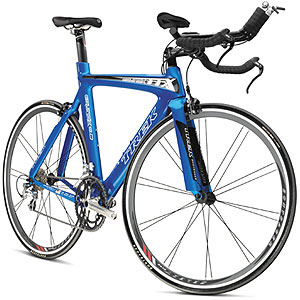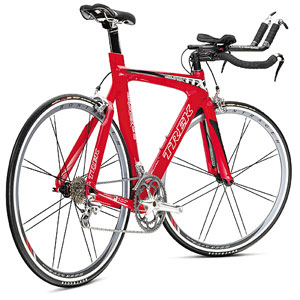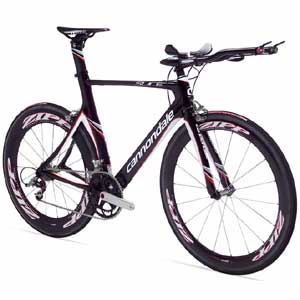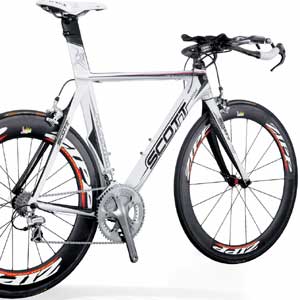Trek’s tri bikes split the geometric difference

Trek, synonymous with American cycling over the last third-century, was for years ambivalent about what we call the consensus triathlon geometry. Its triathlon business was, after all, doing fine prior to the turn of the decade. Its bikes “won” the Kona Survey most of the time since that Survey’s inception in 1992. Its sponsored pros over the past two decades — which have included Mike Pigg, Karen Smyers, Chris Lieto, Tim DeBoom, Cam Widoff — performed admirably. And, of course, there was Lance, Trek’s most productive “sponsored triathlete.”
The story behind the story was that most of Trek’s triathlon-related sales consisted of its road race bikes and Lance, who hadn’t raced a triathlon since 1991, raced in an “outlier” position atypical of the majority of time trial and triathlon specialists. As a result, Trek’s time trial bikes built for Lance fit so awkwardly for those needing that “consensus position” that one of its sponsored athletes, Peter Reid, couldn’t ride the then-flagship Trek Team Time Trial, instead riding one-off aluminum frames carrying the Trek headbadge.
Its lead in the Kona count started to diminish, and then its numbers fell precipitously. Retailers loyal to Trek still sold the road bikes, but less so to those racing triathlons. They abandoned the brand’s tri offerings for Cervelo, Felt, and those of other tri-specific companies. All that would’ve been okay in a niche activity, except triathlon was becoming less niche and more mainstream. Tri was growing, and Trek’s tri bikes were lemons.
That was then.
Out of lemons Trek has made lemonade, and succumbed to other beverage metaphors. It awakened to smell the coffee. It drank the Kool Aid. Trek’s engineers and product managers recognized the utility and viability of the consensus geometry and have admirably bridged to the front pack with its Equinox TTX line. Let’s look it over.
Trek appears to have chosen to imbue its frame with, in equal measure, attention to aerodynamics and stiffness in the lateral plane. In all probability and for most people the aerodynamics will be of greater importance. Frame stiffness is not the requirement for timed racing that it is for road racing, but such attention to stiffness doesn’t do the frame any harm. Trek produced its infamous white paper earlier this year to tout the aerodynamic benefit, and the Slowtwitch reader forum provided an element of peer review that placed the white paper in context (search our forum for Trek White Paper and you’ll find the thread).

The admirable thing about this series of bikes is its affordability. Just as with Quintana Roo, Felt, Scott, Cannondale and others, Trek differentiates its carbon bike models through different carbon layup schedules placed into one size run of molds. The Equinox TTX 9.0 (the pictured bike in blue) is made of “white” carbon, that is, value carbon. The 9.5 and 9.9 uses black carbon, so to speak, and the 9.9 SSL is made of red carbon. This layup nomenclature is standard throughout its OCLV line of bikes. The higher the grade, the greater the amount of high modulus carbon.
How much difference does this really make in how one of these Trek bikes is going to ride compared to the other? Probably not much, because the two most notable differences are weight and stiffness. The weight difference in the frame is immaterial compared to the overall weight of the rider/bike system (though the 9.9SSL is very light) and the frame is already so laterally stiff that you could make the whole thing out of fiberglass and it would ride reasonably well.
Accordingly, the Equinox TTX 9.0 is, for $3000, built on the same chassis as all of its more expensive siblings up to and including those ridden by grand tour teams like Discovery and now Astana. This makes it an elegant choice for a triathlete, assuming it’s the right geometry, built with the right groupkit, assembled the right way, fit to you properly. Let’s talk about the geometry and the groupkit configurations.
The Equinox TTX is a dual-IQ capable frame, just like the Felts and the Cervelos. Trek’s palindromic seat post is oval in shape, which can be flipped offsetting the saddle clamp hardware in ways conforming to the retailer’s IQ, that is, the frame can function for retailers smart and intuitive, and for those less so.
Should the retailer flip the seatpost back (less so), the groupkit’s pursuit bar and aerobar is about right in elevation. Should the seat post be flipped forward (so-executed by the "smart and intuitive" retailers) the aerobar spec (whether the Profile Design Aerolite on the 9.0 or the Bontrager Race X Carbon Lite on the 9.9) may be altitude challenged, that is, the customer may find it a challenge to get the aerobars low enough relative to the saddle. This is because the Equinox geometry is a tweener. It’s not low and long like bikes made by Cervelo, or all the newer models by QR, Felt, Jamis, Wilier, Giant and Kuota. It’s also not compact and high like tri bikes made by Cannondale and Scott. It’s a little of each, and this means the higher profile aerobars spec’d on the Equinox models may not be the bars appropriate for you, depending on whether you’re fat, skinny, leggy, stumpy, or whatnot. It’s like Cervelo’s P3C in that a lot of people who buy this bike would best ride it with aerobars other than those spec’d as original equipment. The P3C will have to have many of its Visiontechs removed and replaced with bars like the Profiles or Bontragers featured on the Equinoxes. A lot of these bars will provide the elevation enhancements needed by certain of the P3C’s customers. Conversely, the Equinox TTX will need to have some of its OE bars yanked and replaced by bars with the elevation of Visiontechs.
The fact that the Equinox TTX is an expensive lineup, coupled with the necessity, at times, to "re-spec" the bike with another handlebar set-up, calls for some discussion of Trek's distribution. Earlier I wrote some paragraphs that served as a forward to the body of this article. In them I mentioned that Trek’s good dealers abandoned Trek’s tri models in favor of other brands, during the interregnum separating Trek’s heyday as a big time tri brand (selling its road bikes to triathletes) and now, when it really does have a first class tri bike to sell to triathletes. The hard truth is that it’s not that easy to find that first class Trek retailer who understands these intracacies of the Equinox line. A lot of those who’ve remained loyal Trek sellers are very good retailers overall, but less sophisticated in the tri market. And this bike requires a sophisticated dealer. Let us take, for example, a big tri market like Chicagoland. When I think of those retailers who might have size runs of Equinoxes, and those retailers who might be the ones I’d go to for sophisticated work on my tri bike fit, those are not the same retailers (with some few exceptions). Trek is going to have to work hard to make sure this first class bike is sitting on showroom floors of first class tri dealers who know how to sell it, and properly fit people to it.

Next up from the Equinox TTX 9.0 is the 9.5 (the red bike pictured). It’s $800 more, and it’s got the black carbon versus the white, and Ultegra versus 105. It’s also got Bontrager aerobars, which I’m assuming are nice since Bontrager has worked hard to replace the HED bars under Lance and his Discovery teammates with Bontrager bars the Discovery Team could successfully ride — but I have no firsthand knowledge of these bars.
The TTX 9.9 is the same frame-with-black-carbon but it’s all Dura Ace, with Bontrager Race X Lite Aero wheels, and the $1500 you pay for this Ultegra to Dura Ace upgrade is more than the market ought to bear. Probably, the 9.5 is the pick of the litter.
Interesting to me is the fact that SRAM’s Red Group is on the $8300 9.9 SSL (the black bike pictured at the top of the article), Trek’s cost-no-object version of the TTX. Yes, this occurred because SRAM is the Astana sponsor, and this is the Astana TT bike. Still, if I’m Shimano, I’m grumpy. Trek is historically Shimano’s flagship worldwide client and Trek’s posture says that the Red Group rules, since its on my cost-no-object TTX.
Is this 9.9 SSL a good buy? Maybe, but if I’m the customer I’m grumpy, because the single best component in SRAM’s TT version of the Red Group is that fine brake lever, and it’s the one thing that’s left off this bike, in favor of Bontrager’s lever. Still, the 9.9 SSL is 300 grams lighter than the 9.9, a fairly healthy two-thirds of a pound drop in frame weight. Is it worth it in terms of cost/benefit? No. Is it a worthy of purchase cost-no-object? You bet. It’s sexy.
Trek does make the Equinox 5 and 7, which are perfectly adequate entry level tri bikes at $1400 and $1800 respectively.



